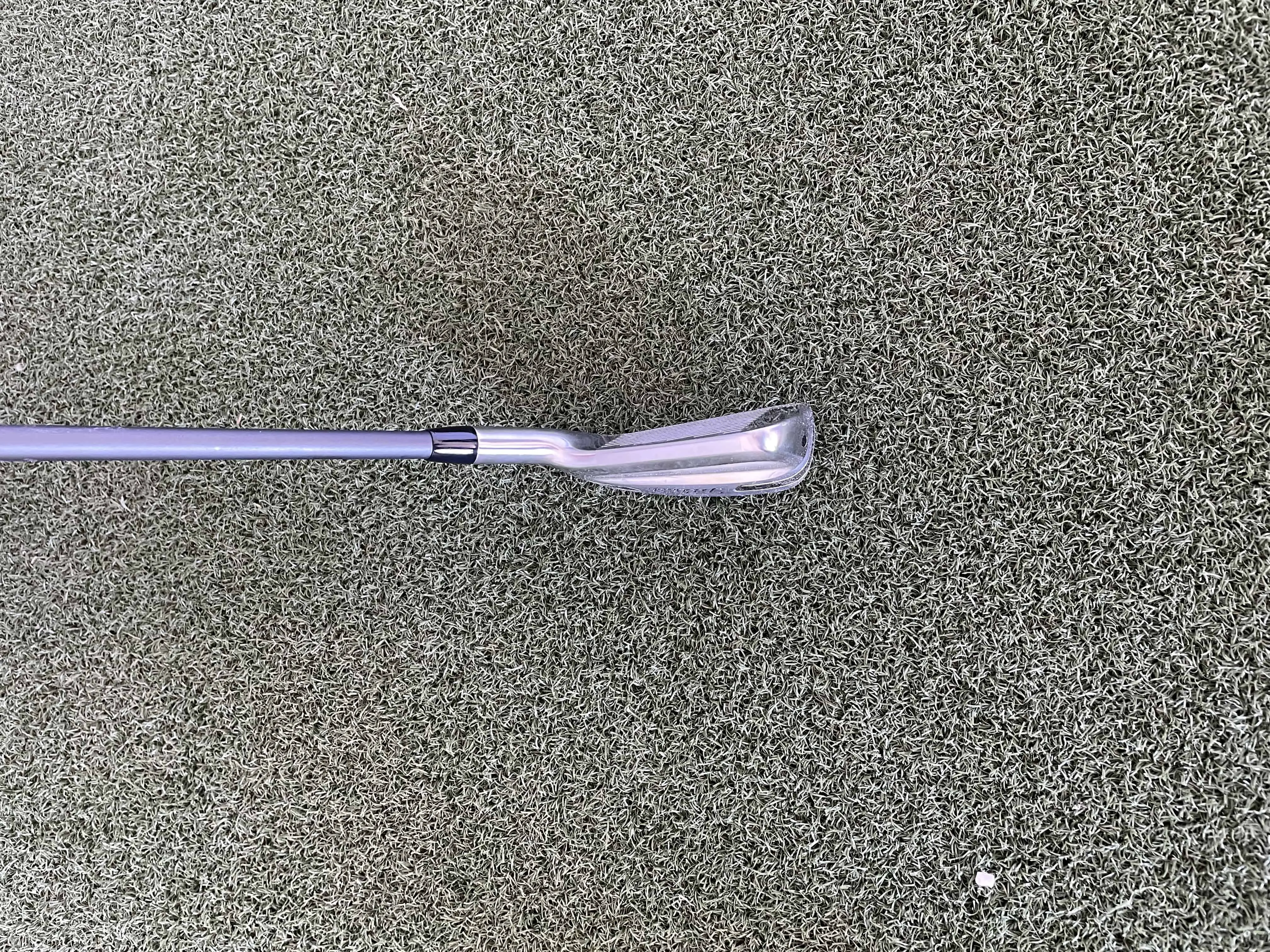Many beginner golfers dream of hitting the draw shot in golf.
They fight the slice early on and spend years trying to figure out how to turn the ball over right to left.
The more advanced golfer can typically hit a draw and might eventually fight the hook.
The ultimate is finally developing a stock shot where the golfer can start the ball consistently on a start line and have it turn over right to left.
Below, we will dive into many topics related to the draw shot in golf:
- What is a draw shot in golf
- Why do golfers want to hit a draw shot
- The ball flight laws related to a draw
- How to hit a draw
- How to develop a stock shot that is a draw
- 3 Fundamentals to take your game to the next level
When to hit a draw in golf (3 key situations)

What is a draw shot in golf?
The draw shot for the right handed golfer is a shot that curves slightly from right to left in the air. For a lefty the shot will draw from left to right. There are some advantages to the draw shot and the best golfers often hit a draw shot at some point in their golf journey.
There are different forms of the draw shot in golf.
The first one is the shot that starts to the right of the target line and then curves left towards the pin or the target. This is the most common draw that you will find among the single digit handicap golfers and the professional golfers.
The second one is the shot that starts slightly left and then continues to curve left. Some of the best golfers of all time including Anrold Palmer and Sam Snead have been said to hit a slight pull draw. The adjustment they needed to make was to aim a bit further to the left.
The key to any quality golf is being able to hit your target line and have a predictable curve to the shot. Whether you start it right and it draws or it starts somewhat left and draws, the key is to do whatever you do, consistently.
Why do golfers want to hit a draw shot?
The draw shot is a rather efficient shot shape in the game of golf. When the golf is able to stay shallow and hit a slight baby draw, it often produces the most distance, the appropriate spin rate, and a quality trajectory. All three of these attributes are important in hitting one quality shot after another.
The draw shot has been said to have additional distance vs the fade shot in golf. Many of the power hitters in golf will sometimes turn to the fade shot to help eliminate the hook shot in golf. However, as most professionals are coming up and through the junior ranks, the most common shot is going to be a draw.
Many teachers want golfers approaching the shot from the inside to maximize the key numbers in a golf swing and this swing typically produces a draw shot.

The ball flight laws related to a draw
Understanding the ball flight laws is important to help you understand what actually causes the draw shot in golf. For many years, golf instructors believed that the swing path had the greatest impact on the start line, but the new technology has shown us that the ball will start relative to the clubface at impact.
As a result, the push draw is hit with a club face that is open to the target line, but closed to the path.
Myth Busted: The teachings that the clubface had to be closed were false. Yes it must be closed to the path, but it needs to be open to the target line if you want to hit a push draw. Bottom line…you can hit a draw with an open club face!
The basic idea of the ball flight is that the ball will start in the direction that the club face is pointing at impact. The clubface controls about 75% of where the ball will start.
From there it will curve based on the swing path relative to the club face.
For example, if your club face is 2 degrees right and your path is 4 degrees right. The ball will start right and curve left towards the target, which is away from the swing path direction.
To develop a consistent shape in your shot pattern, you will attempt to build similar numbers with the majority of your golf swings.
Below, I will provide several examples that help you practice what way your ball will curve and get the general understanding of what is taking place. The goal is to eliminate the shot that starts and curves in a different direction then what you are intending to do.
This will help eliminate big numbers from your scorecard.
Having this information will help you make the adjustments mid round or post round and not get stuck in the rabbit hole of swing corrections.
I provide three examples below, all which include a club face that is right and a path that is right. You can see how a slight variation in the difference between the face and the path can cause a ball to curve.
Ball Flight Laws: Scenario 1
Clubface: 3 degrees right
Swing Path: 3 degree right
The ball will start right of the target line (club face is 3 degree open or right) and fly straight since the clubface and the swing path are the same number of degrees open or right of the target line.
The end result is a push shot. The ball will start right and stay right.
Ball Flight Laws: Scenario 2
Clubface: 3 degrees right
Swing Path: 5 degree right
The ball will start right of the target line (club face is 3 degree open or right) and curve away from the swing ptch, which means it will curve left.
The end result is a draw shot. The ball will curve a decent amount with these numbers.
This shot would be considered a push draw.
Ball Flight Laws: Scenario 3
Clubface: 3 degrees left
Swing Path: 10 degree left
The ball will start left of the target line (club face is 3 degree closed or open) and slice since there is a big gap between clubface and swing path. The end result is a pull slice. The ball will start left and curve hard to the right.
This is a shot that many amateurs struggle with. They continue to aim further and further left. The swing path keeps moving left and the face remains open. The end result is a full slice.
This last example is the opposite of an inside out golf swing.

How to hit a draw?
What we learned above with the ball flight laws it the following:
- We need an open clubface relative to the target line
- A path that is further right than the clubface
Now that we understand they two keys above, here are some simple steps we can take.
- Have the face slightly open at setup.
- Have a slightly closed stance at setup.
- Swing along your stance line
Start with these three factors and read the ball flight. Some items to consider:
- Did your golf ball start right or left of your targe line?
- What direction did it curve?
If it didn’t start right of the target line…your clubface was closed at impact.
If the ball started right of the target line, but did curve left…your path was not far enough to the right.
Complete post on how to hit a draw in 5 simple steps
How to develop a stock shot that is a draw
The ability to start your ball down the intended start line and have it curve in a predictable direction is paramount to your overall success as a golfer and hitting more fairways. If you watch the best golfers you can find at your home golf course, they will often have a predictable shot pattern with a smaller dispersion than the worst golfers.
Whether you play a stock draw or a stock fade, the key is to have your golf ball consistently curve in the same direction. You do not need to work the ball both ways, if you can control the curve of your golf ball.
Practice this drill and then complete an assessment at least once a week and chart your progress. Understanding the ball flight laws will help you develop this shot.
If you want to hit a draw, make sure you setup the drill to learn to hit a stock draw.
Complete Post: Ball Flight Laws Explained
The Stock Shot Drill
- Set up an alignment stick about 6-8 yards in front of you, straight down your target line.
- If you have a second alignment stick, set the stick 2-3 feet right of the first stick (for a draw) or left of the first stick (for a fade).
- Complete your initial assessment see how many times out of 10 you can start the ball to the right or left of your target. Pick one side and measure your game at this point.
- The goal is to eventually get 7 out of 10 shots to start to the correct side and draw back towards the target.

3 Fundamentals to take your game to the next level
If you want to take your game to the next level, we must get good at the three fundamentals below. No, we don’t get into the grip, or ball position or grip tension, etc. The three fundamentals are all swing produced results.
The Stack and Tilt Instructors said it best when they described what they believed were the fundamentals of golf. They explained it somewhat similar to this:
- The first fundamental is the golfer’s ability to control the bottom of the golf swing. The best golfers will hit the ground in the intended spot, close to 100% of the time.
- The second fundamental is the golfer’s ability to control the curve of the golf ball. The best golfers are able to start the ball to the right or left of the target line and have the ball curve towards the target without the ball over-curving past the target.
- The third fundamental is the golfer’s ability to have enough power to play the golf course. This means they are able to hit the ball far enough to play the course in regulation.
They promoted a draw, I would promote whatever you can hit consistently.
Final Thoughts: Study Your Swing and Then Own Your Swing
When you hit a bad shot, make sure you watch the entire flight and know what the ball actually does. Too many golfers turn in frustration instead of connecting the feel or the swing with the result. If you hit a pull hook, did you feel your hands and your body come through too much?
Now that you understand the ball flight laws and the keys to hitting a draw, oftentimes your best teacher is your ball flight. You know the adjustments to make, keep your adjustments simple and hit your shot!
One thing that has helped me greatly is my SkyTrak Launch Monitor.
It provides instant feedback on club speed, club face, spin axis and spin loft. When playing in my golf simulator in my garage, I am able to work on my start line and club head control. This helps me make adjustments when I actually play on a course.
The simulator golf has helped me reduce 4-6 shots by working mainly on tips #1 and #2. The game of golf doesn’t have to be complicated, work to keep it simple and to read your ball flight!
Many of our worst shots are caused by our fears of certain misses and we get in our own way.
The great news is that a place like Rain or Shine golf has great deals and offers financing. Check them out below:

Take Action – What You Can Do Today to Get Better
What does this mean for you? I believe in the following recipe to get better:
1 – Improve your motion in the golf swing by identifying a golf instructor. Here are some options:
Here is a list of golf instructors that we have reviewed:
2 – Train to swing faster and improve your swing speed. Here are some options:
Looking to gain more Speed and Distance in your swing. Two Options:
3 – Understand course strategy and work to break through your next barrier. Here is a series on breaking through:
We have provided guides on how to break 100, 90, 80 and 70. Check out more below, if interested.
4 – Practice Frequently
Did you know that I build a golf simulator in my garage and have played over 500 rounds of golf on my SkyTrak system? It has been a game changer and one worth checking out. Here are some of my other posts on golf simulators frequently asked questions:
- Is a Golf Simulator Worth It?
- How to Build a Golf Simulator?
- What is the Best Golf Simulator?
- Golf Simulator Accessories?
- How to Build a Golf Simulator for under $7000
- Top 11 Reasons to Buy a SkyTrak
- How to Build a Golf Simulator for Under $1000
- Why Build A Golf Simulator?
- What Space is Needed?
- Can A Golf Simulator Improve My Game?
- How Much Does A Golf Simulator Cost?
- Don’t Forget to Check out our 15 best golf swings of all time.
